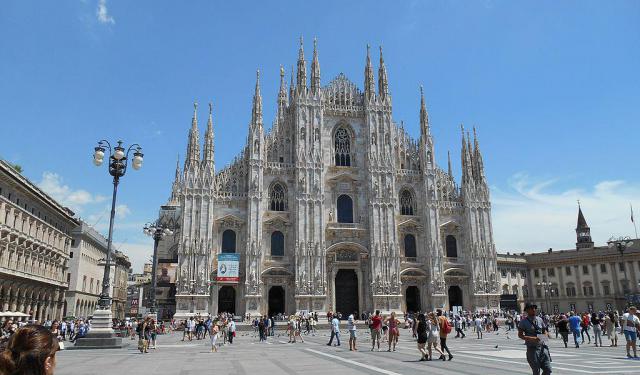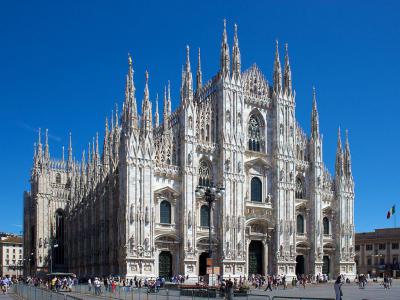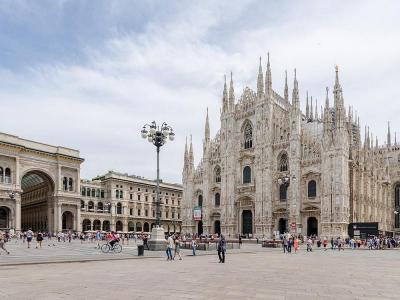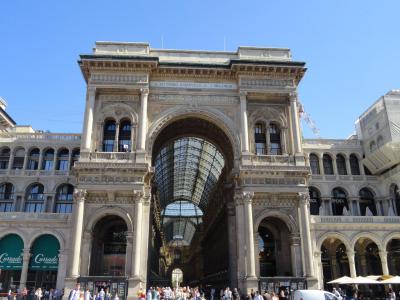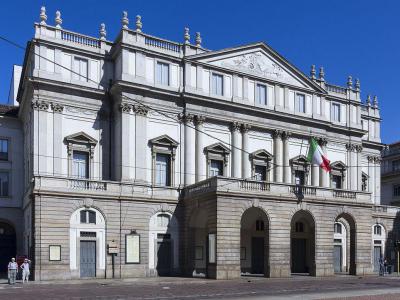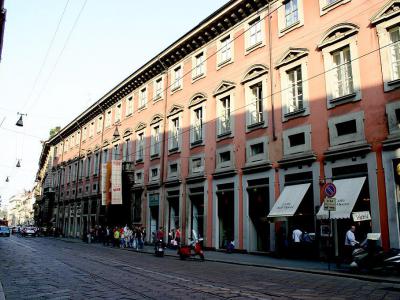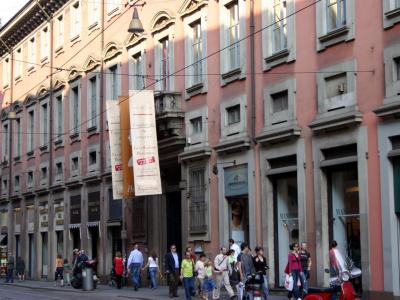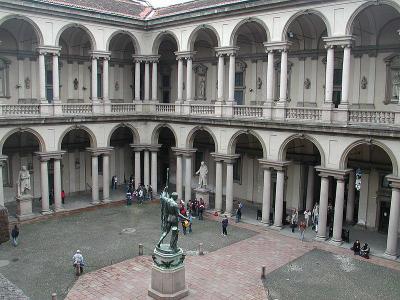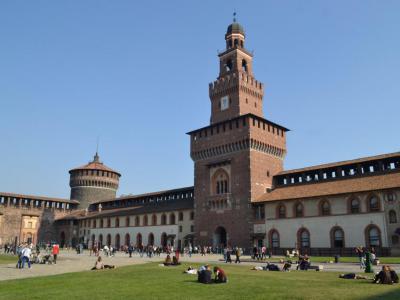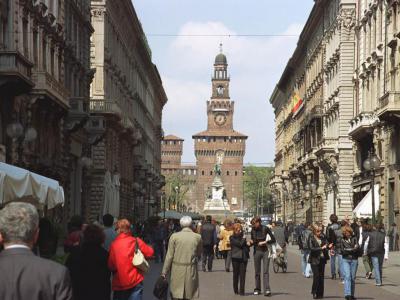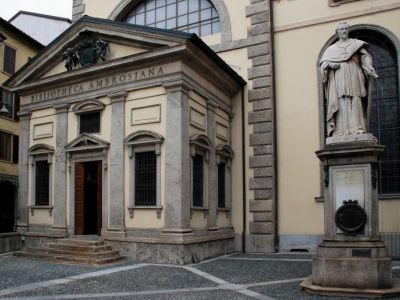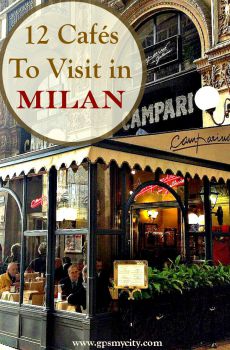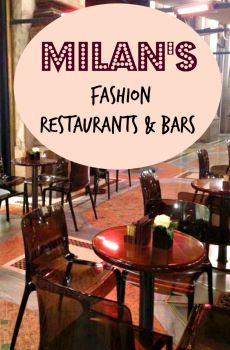Milan Introduction Walking Tour (Self Guided), Milan
Recognized as one of the world's four fashion capitals, Milan is also a global hub of design and a key tourist destination. The etymology of the name Milan remains uncertain. One theory holds that the Latin name Mediolanum comes from the Latin words medio (in the middle) and planus (plain).
In 286 the Roman Emperor Diocletian moved the capital of the Western Roman Empire from Rome to Mediolanum. From here, the Emperor Constantine issued the Edict of Milan in 313 AD, granting tolerance to all religions within the Empire, thus paving the way for Christianity to become the dominant religion of Roman Europe.
In the course of the 12th-20th centuries Milan had endured multiple geopolitical transformations, changing from an independent duchy in 1183 to a subordinate of Habsburg's Spain in 1525 to becoming part of the Austrian Empire in 1713–1714 to being declared a capital of the Kingdom of Italy after the Napoleonic invasion in 1796 to returning back to Austrian control in 1815. In the 1920s, Milan was also the place where Benito Mussolini started his political and journalistic careers.
Still, Milan's main footprint in history for the said period is firmly associated with arts and, most importantly, with Leonardo da Vinci who worked in the city from 1482 until 1499, commissioned to paint the Virgin of the Rocks for the Confraternity of the Immaculate Conception and The Last Supper for the monastery of Santa Maria delle Grazie. The Pinacoteca del Castello Sforzesco also holds Leonardo da Vinci's Codex Trivulzianus manuscript. As a major international center of the performing arts, most notably opera, Milan is also a home to the La Scala operahouse, considered to be one of the world's most prestigious.
In the 1980s Milan became one of the world's fashion capitals, courtesy of the local fashion houses, such as Armani, Versace and Dolce & Gabbana. In the early 21st century, the city underwent a series of sweeping redevelopments over huge former industrial areas, followed by a great expansion of publishing, finance, banking, fashion design, information technology, logistics and tourism.
Today's Milan is an affluent metropolis known for its high-end restaurants and shops, enjoying steady inflow of visitors coming to see the local landmarks, such as The Gothic Duomo di Milano cathedral and many others. If you're one of them, take this self-guided tour to explore some of the top locations on the tourist map of Milan!
In 286 the Roman Emperor Diocletian moved the capital of the Western Roman Empire from Rome to Mediolanum. From here, the Emperor Constantine issued the Edict of Milan in 313 AD, granting tolerance to all religions within the Empire, thus paving the way for Christianity to become the dominant religion of Roman Europe.
In the course of the 12th-20th centuries Milan had endured multiple geopolitical transformations, changing from an independent duchy in 1183 to a subordinate of Habsburg's Spain in 1525 to becoming part of the Austrian Empire in 1713–1714 to being declared a capital of the Kingdom of Italy after the Napoleonic invasion in 1796 to returning back to Austrian control in 1815. In the 1920s, Milan was also the place where Benito Mussolini started his political and journalistic careers.
Still, Milan's main footprint in history for the said period is firmly associated with arts and, most importantly, with Leonardo da Vinci who worked in the city from 1482 until 1499, commissioned to paint the Virgin of the Rocks for the Confraternity of the Immaculate Conception and The Last Supper for the monastery of Santa Maria delle Grazie. The Pinacoteca del Castello Sforzesco also holds Leonardo da Vinci's Codex Trivulzianus manuscript. As a major international center of the performing arts, most notably opera, Milan is also a home to the La Scala operahouse, considered to be one of the world's most prestigious.
In the 1980s Milan became one of the world's fashion capitals, courtesy of the local fashion houses, such as Armani, Versace and Dolce & Gabbana. In the early 21st century, the city underwent a series of sweeping redevelopments over huge former industrial areas, followed by a great expansion of publishing, finance, banking, fashion design, information technology, logistics and tourism.
Today's Milan is an affluent metropolis known for its high-end restaurants and shops, enjoying steady inflow of visitors coming to see the local landmarks, such as The Gothic Duomo di Milano cathedral and many others. If you're one of them, take this self-guided tour to explore some of the top locations on the tourist map of Milan!
How it works: Download the app "GPSmyCity: Walks in 1K+ Cities" from Apple App Store or Google Play Store to your mobile phone or tablet. The app turns your mobile device into a personal tour guide and its built-in GPS navigation functions guide you from one tour stop to next. The app works offline, so no data plan is needed when traveling abroad.
Milan Introduction Walking Tour Map
Guide Name: Milan Introduction Walking Tour
Guide Location: Italy » Milan (See other walking tours in Milan)
Guide Type: Self-guided Walking Tour (Sightseeing)
# of Attractions: 11
Tour Duration: 2 Hour(s)
Travel Distance: 3.9 Km or 2.4 Miles
Author: DanaOffice
Sight(s) Featured in This Guide:
Guide Location: Italy » Milan (See other walking tours in Milan)
Guide Type: Self-guided Walking Tour (Sightseeing)
# of Attractions: 11
Tour Duration: 2 Hour(s)
Travel Distance: 3.9 Km or 2.4 Miles
Author: DanaOffice
Sight(s) Featured in This Guide:
- Duomo di Milano (Milan Cathedral)
- Piazza del Duomo (Cathedral Square)
- Galleria Vittorio Emanuele II (Vittorio Emanuele II Gallery)
- La Scala (Opera House and Museum)
- Museo Poldi Pezzoli (Poldi Pezzoli Museum)
- Via Manzoni (Manzoni Street)
- Pinacoteca di Brera (Brera Art Gallery)
- Castello Sforzesco (Sforzesco Castle)
- Via Dante (Dante Street)
- Biblioteca Ambrosiana (Ambrosian Library & Art Gallery)
- Via Torino (Torino Street)
1) Duomo di Milano (Milan Cathedral) (must see)
The Milan Cathedral, otherwise known as the Duomo, is the seat of the Archbishop of Milan and the largest church in Italy (the third largest in Europe and the fourth largest in the world), covering an area of 12,000 sqm and weighing a staggering 325,000 tons!
The cathedral is dedicated to Saint Mary Nascent and has been the epicenter of the city's life since 1386. Its foundation was laid by Gian Galeazzo Visconti, who died in 1402 when only half of the structure had been finished, upon which the construction came to a standstill for almost 80 years because of the lack of funds and ideas. It resumed only in 1500, and by 1510 the octagonal dome was completed – embellished with four series of 15 statues representing different characters from the Bible.
In 1805, Napoleon Bonaparte forced completion of the façade, which overall took another seven years of work. In honor of his efforts, a statue of Napoleon was erected at the top of one of the spires. Later, the Duomo also hosted his crowning ceremony. However, it wasn't until the 20th century, with the completion of the last gate, that the centuries-long construction of the cathedral was finally over, marked by inauguration on January 6, 1965.
A climb to the roof, much as a descend to the Paleo Christian baptistery beneath the west side of the Duomo are the highlights of a visit here. The rooftop offers a closer look at the intricate details of the spires and the gargoyles adorning it, plus a breathtaking view over of the city, some 70 meters above ground, replete with myriads of statues, pinnacles, tracery and flying buttresses. In order to get there, visitors have to traverse 201 stairs up through a winding narrow passageway, which is a bit tiring. Still, those who wish, can spare the effort and use an elevator.
Why You Should Visit:
Milan's one truly must-visit sight – a vast riot of ornate religious sculpture on the exterior, and the interior sublimely huge.
Tip:
Buy an online skip-the-line ticket that covers entry and access to the elevator.
The surrounding piazza comes at its finest at night when the cathedral's façade is lit by white lights.
The cathedral is dedicated to Saint Mary Nascent and has been the epicenter of the city's life since 1386. Its foundation was laid by Gian Galeazzo Visconti, who died in 1402 when only half of the structure had been finished, upon which the construction came to a standstill for almost 80 years because of the lack of funds and ideas. It resumed only in 1500, and by 1510 the octagonal dome was completed – embellished with four series of 15 statues representing different characters from the Bible.
In 1805, Napoleon Bonaparte forced completion of the façade, which overall took another seven years of work. In honor of his efforts, a statue of Napoleon was erected at the top of one of the spires. Later, the Duomo also hosted his crowning ceremony. However, it wasn't until the 20th century, with the completion of the last gate, that the centuries-long construction of the cathedral was finally over, marked by inauguration on January 6, 1965.
A climb to the roof, much as a descend to the Paleo Christian baptistery beneath the west side of the Duomo are the highlights of a visit here. The rooftop offers a closer look at the intricate details of the spires and the gargoyles adorning it, plus a breathtaking view over of the city, some 70 meters above ground, replete with myriads of statues, pinnacles, tracery and flying buttresses. In order to get there, visitors have to traverse 201 stairs up through a winding narrow passageway, which is a bit tiring. Still, those who wish, can spare the effort and use an elevator.
Why You Should Visit:
Milan's one truly must-visit sight – a vast riot of ornate religious sculpture on the exterior, and the interior sublimely huge.
Tip:
Buy an online skip-the-line ticket that covers entry and access to the elevator.
The surrounding piazza comes at its finest at night when the cathedral's façade is lit by white lights.
2) Piazza del Duomo (Cathedral Square) (must see)
The gigantic central piazza, milling with people and pigeons, is awe-inspiring, with the Museo del Novecento being a particularly impressive sight. No cafés spill onto it, but the historic Camparino is tucked under the porticoes, created by the founder of the Campari dynasty in 1867. It was here, at the entrance to Galleria Vittorio Emanuele, that Verdi used to enjoy a drink after concerts and where, in 1877, Milanese nobility flocked to see the first experiment in electric lighting. It was also here, in this Art Nouveau interior, that stressed Milanese still relax over a coffee or Campari, served with over-sized olives.
The Palazzo Reale (Royal Palace) on the south side of the Duomo stands on the site of the original Broletto or town hall, destroyed by Frederick Barbarossa in 1162. It was rebuilt in 1171, then later transformed into the Ducal Palace for the Visconti and Sforza dynasties. On the occasion of Galeazzo Visconti’s marriage to Beatrice d’Este in Modena, their entry into Milan was marked by eight days of festivities at the palace. In 1336 the Church of San Gottardo in Corte was built as the Visconti’s private chapel. You can still see the charming colonnaded campanile rising to the rear of the palace, but the church itself was destroyed when the building was incorporated into the neoclassical palace. In 1412 the church steps were the scene of the murder of Giovanni Maria Visconti; as a consequence, the family decided to reside in the safer environs of the fortified castle. Under the Sforza a theatre was established at the palace, and in 1595 Mozart, who was only 14, performed here.
Another unmissable landmark in the piazza is, of course, Ercole Rosa's 1896 equestrian statue of Vittorio Emanuele II, first king of Italy, who triumphantly entered Milan in 1859.
The Palazzo Reale (Royal Palace) on the south side of the Duomo stands on the site of the original Broletto or town hall, destroyed by Frederick Barbarossa in 1162. It was rebuilt in 1171, then later transformed into the Ducal Palace for the Visconti and Sforza dynasties. On the occasion of Galeazzo Visconti’s marriage to Beatrice d’Este in Modena, their entry into Milan was marked by eight days of festivities at the palace. In 1336 the Church of San Gottardo in Corte was built as the Visconti’s private chapel. You can still see the charming colonnaded campanile rising to the rear of the palace, but the church itself was destroyed when the building was incorporated into the neoclassical palace. In 1412 the church steps were the scene of the murder of Giovanni Maria Visconti; as a consequence, the family decided to reside in the safer environs of the fortified castle. Under the Sforza a theatre was established at the palace, and in 1595 Mozart, who was only 14, performed here.
Another unmissable landmark in the piazza is, of course, Ercole Rosa's 1896 equestrian statue of Vittorio Emanuele II, first king of Italy, who triumphantly entered Milan in 1859.
3) Galleria Vittorio Emanuele II (Vittorio Emanuele II Gallery) (must see)
Galleria Vittorio Emanuele II is a fashionable five-storey mall covered in curved glass, topped with iron roof and lavishly decorated with patriotic mosaics and statues – legacy of the chaotic era of Italian unification, manifesting the country's newly-acquired self-confidence.
It was built between 1865 and 1877 by architect Giuseppe Mengoni – who is also credited with the monumental design of the entire area between the Milan Cathedral and La Scala – and is named after Vittorio Emanuele II, the first king of unified Italy. Officially inaugurated on September 15, 1867, the Galleria's completion took another ten years of continuous work. Tragically, just a day before it was over, in December 1877, Giuseppe Mengoni died in accident, falling down from the top of the triumphal arch.
Designed in the form of a Latin cross, the gallery comprises two glass-vaulted covered passages, with the longer one being 196 meters and the shorter – 105.5 meters long, crossing in an octagonal central piazza below an impressive 47-meter high, 36-meter wide glass dome. Incorporating iron and arching glass, the Galleria's architectural design proved groundbreaking for the creation of enclosed shopping malls in the 19th century. Moreover, its use of an iron structure inspired the Eiffel Tower in Paris.
An interesting feature of the gallery is the floor adorned with marble mosaics depicting emblems of the main Italian cities. Locals believe that stepping on the bull's image in the middle of the floor with a heel of the right foot and spinning around can bring good luck. Adherence to this tradition has already left a hole there.
Why You Should Visit:
Almost like stepping into the picture of 19th-century Milan with its lights, colors, windows and landscaping that will never fade in your memory.
There are a few restaurants (incidentally not very expensive, considering it's 'the mall') where you can sit back, eat to your heart's content, and watch the crowds go by.
There's also a very nice Leonardo Museum at the end of the mall, bang opposite the statue of Leonardo da Vinci.
Tip:
Try to visit late at night or early in the morning when there aren't that many people in.
Don't forget to find the "bull" on the floor and have fun!
It was built between 1865 and 1877 by architect Giuseppe Mengoni – who is also credited with the monumental design of the entire area between the Milan Cathedral and La Scala – and is named after Vittorio Emanuele II, the first king of unified Italy. Officially inaugurated on September 15, 1867, the Galleria's completion took another ten years of continuous work. Tragically, just a day before it was over, in December 1877, Giuseppe Mengoni died in accident, falling down from the top of the triumphal arch.
Designed in the form of a Latin cross, the gallery comprises two glass-vaulted covered passages, with the longer one being 196 meters and the shorter – 105.5 meters long, crossing in an octagonal central piazza below an impressive 47-meter high, 36-meter wide glass dome. Incorporating iron and arching glass, the Galleria's architectural design proved groundbreaking for the creation of enclosed shopping malls in the 19th century. Moreover, its use of an iron structure inspired the Eiffel Tower in Paris.
An interesting feature of the gallery is the floor adorned with marble mosaics depicting emblems of the main Italian cities. Locals believe that stepping on the bull's image in the middle of the floor with a heel of the right foot and spinning around can bring good luck. Adherence to this tradition has already left a hole there.
Why You Should Visit:
Almost like stepping into the picture of 19th-century Milan with its lights, colors, windows and landscaping that will never fade in your memory.
There are a few restaurants (incidentally not very expensive, considering it's 'the mall') where you can sit back, eat to your heart's content, and watch the crowds go by.
There's also a very nice Leonardo Museum at the end of the mall, bang opposite the statue of Leonardo da Vinci.
Tip:
Try to visit late at night or early in the morning when there aren't that many people in.
Don't forget to find the "bull" on the floor and have fun!
4) La Scala (Opera House and Museum) (must see)
The La Scala Theatre Chorus, Ballet, and Orchestra make it one of the premier musical theaters worldwide. Inaugurated in 1778, the famous opera house in Milan has welcomed some of the finest singers from Italy and around the globe.
After the Teatro Regio Ducale burned down in 1776, a new theater was erected on the site of the former church of Santa Maria alla Scala, from which it derived its name. The cost of building the theater was covered by sales of theatrical boxes, which were exquisitely decorated and made a lasting impression on guests, including the prominent French author Stendhal. Soon, La Scala became a preferred gathering spot for high society. In accordance with the tradition of the time, the main floor had no chairs, and audiences had to stand to watch the shows. Additionally, the orchestra pit had yet to be constructed.
Badly damaged during World War II, La Scala underwent a complete restoration before reopening in 1946. To commemorate the occasion, Arturo Toscanini arranged an unforgettable concert featuring a sensational solo by Renata Tebaldi. From 2002 to 2004, the theater underwent a major renovation. Despite its plain facade, the La Scala interior is stunningly elegant and intimate, surpassing that of opera houses in New York and London.
Why You Should Visit:
The La Scala Orchestra, comprising 135 musicians, is one of the world's most outstanding orchestras for opera productions, known for its ability to produce a uniform and distinguished sound. The theater is also internationally acclaimed for its symphonic activities. The La Scala museum houses one of the richest and most coveted collections of music-themed artifacts worldwide. A tour of the theater provides a rare opportunity to sit in its most prominent box and take photos.
Tip:
Do not buy second-row balcony tickets unless you are quite tall.
After 6pm, same-day tickets are sold at a substantial discount.
After the Teatro Regio Ducale burned down in 1776, a new theater was erected on the site of the former church of Santa Maria alla Scala, from which it derived its name. The cost of building the theater was covered by sales of theatrical boxes, which were exquisitely decorated and made a lasting impression on guests, including the prominent French author Stendhal. Soon, La Scala became a preferred gathering spot for high society. In accordance with the tradition of the time, the main floor had no chairs, and audiences had to stand to watch the shows. Additionally, the orchestra pit had yet to be constructed.
Badly damaged during World War II, La Scala underwent a complete restoration before reopening in 1946. To commemorate the occasion, Arturo Toscanini arranged an unforgettable concert featuring a sensational solo by Renata Tebaldi. From 2002 to 2004, the theater underwent a major renovation. Despite its plain facade, the La Scala interior is stunningly elegant and intimate, surpassing that of opera houses in New York and London.
Why You Should Visit:
The La Scala Orchestra, comprising 135 musicians, is one of the world's most outstanding orchestras for opera productions, known for its ability to produce a uniform and distinguished sound. The theater is also internationally acclaimed for its symphonic activities. The La Scala museum houses one of the richest and most coveted collections of music-themed artifacts worldwide. A tour of the theater provides a rare opportunity to sit in its most prominent box and take photos.
Tip:
Do not buy second-row balcony tickets unless you are quite tall.
After 6pm, same-day tickets are sold at a substantial discount.
5) Museo Poldi Pezzoli (Poldi Pezzoli Museum) (must see)
Noble palazzi grace the elegant Via Manzoni, but one historical home not to be missed is the Museo Poldi Pezzoli. Gian Giacomo Poldi Pezzoli, an aristocrat of refined taste, amassed an exquisite collection of art, antiques, and curiosities within his palace. With the help of an inheritance and a group of skilled craftsmen, connoisseurs, and artists, Poldi Pezzoli restored the palace and transformed its apartments into a series of historically-themed rooms inspired by great art periods of the past. He stipulated that upon his death, the building and its priceless treasures should be accessible to the public.
In 1881, the museum opened, and Poldi Pezzoli's passion for arms and armoury formed the core collection. In time, this was supplemented with 15th-18th century Italian paintings, sculpture, Persian carpets, porcelain, and Murano glass. While only four of the original 'Artistic Rooms' survived the bombing of WWII, they have been meticulously restored to their former glory: the rococo-style Stucco Room, the mahogany and ivory-clad Black Room, Pezzoli’s bedroom in the Antique Murano Room, and the Byzantine-influenced Dante study, where he kept his prized possessions.
The museum's highlights include Renaissance masterpieces such as Mantegna's “Portrait of a Man” and “Madonna and Child”, Piero della Francesca's “Deposition” and “St Nicholas of Tolentino”, and Botticelli’s “Madonna and Child” in the Salone Dorato (Golden Salon). However, the portrait that captures the hearts of locals is Pollaiuolo's enchanting “Portrait of a Young Woman” (1441-96), which now serves as the museum's emblem.
As you navigate through the museum, you'll also encounter displays of Venetian glass, 18th-century porcelain, and cabinets shimmering with jewelry.
Why You Should Visit:
A stunning edifice, complemented by an equally impressive art collection that simply demands your attention.
Tip:
This particular establishment is one of the rare few that remain open on Mondays, and its admission fee is quite reasonable, so spending just a little extra on the audio guide is surely worth it.
In 1881, the museum opened, and Poldi Pezzoli's passion for arms and armoury formed the core collection. In time, this was supplemented with 15th-18th century Italian paintings, sculpture, Persian carpets, porcelain, and Murano glass. While only four of the original 'Artistic Rooms' survived the bombing of WWII, they have been meticulously restored to their former glory: the rococo-style Stucco Room, the mahogany and ivory-clad Black Room, Pezzoli’s bedroom in the Antique Murano Room, and the Byzantine-influenced Dante study, where he kept his prized possessions.
The museum's highlights include Renaissance masterpieces such as Mantegna's “Portrait of a Man” and “Madonna and Child”, Piero della Francesca's “Deposition” and “St Nicholas of Tolentino”, and Botticelli’s “Madonna and Child” in the Salone Dorato (Golden Salon). However, the portrait that captures the hearts of locals is Pollaiuolo's enchanting “Portrait of a Young Woman” (1441-96), which now serves as the museum's emblem.
As you navigate through the museum, you'll also encounter displays of Venetian glass, 18th-century porcelain, and cabinets shimmering with jewelry.
Why You Should Visit:
A stunning edifice, complemented by an equally impressive art collection that simply demands your attention.
Tip:
This particular establishment is one of the rare few that remain open on Mondays, and its admission fee is quite reasonable, so spending just a little extra on the audio guide is surely worth it.
6) Via Manzoni (Manzoni Street)
Via Manzoni is a busy and fashionable street in Milan that runs from Piazza della Scala towards Piazza Cavour in the northwest. This impressive refined-air street is lined with aristocratic apartment blocks and opulent churches, as well as quite a few notable buildings, such as the Museo Poldi Pezzoli, the elegant Grand Hotel et de Milan (where composer Giuseppe Verdi passed away in 1901), and several fine palazzi.
The street was named after Alessandro Manzoni, an Italian writer, poet and playwright, on the day of his death in 1873. The reason for it was that the writer lived nearby, on via Morone, at #1168 (now #1), in a house whose garden almost overlooked the street. In the 19th century, Via Manzoni was considered the most luxurious street in Milan.
Today, it is also one of the city's premier shopping destinations – notably a home to the Armani Megastore and a part of Milan’s high-end fashion district, Quadrilatero della Moda. Vogue retailers like Anna Rita N, Antonini, Armani Casa, Artemide, Bolaffi, Bottega del Cashmere, Coccinelle, E. Marinella, Frette, Gattinoni, Grimoldi, Les Copains, Mila Schön, Napapjri, Pal Zileri, Patrizia Pepe, Paul Smith, Scappino and El Ganso have all established their presence here.
The street was named after Alessandro Manzoni, an Italian writer, poet and playwright, on the day of his death in 1873. The reason for it was that the writer lived nearby, on via Morone, at #1168 (now #1), in a house whose garden almost overlooked the street. In the 19th century, Via Manzoni was considered the most luxurious street in Milan.
Today, it is also one of the city's premier shopping destinations – notably a home to the Armani Megastore and a part of Milan’s high-end fashion district, Quadrilatero della Moda. Vogue retailers like Anna Rita N, Antonini, Armani Casa, Artemide, Bolaffi, Bottega del Cashmere, Coccinelle, E. Marinella, Frette, Gattinoni, Grimoldi, Les Copains, Mila Schön, Napapjri, Pal Zileri, Patrizia Pepe, Paul Smith, Scappino and El Ganso have all established their presence here.
7) Pinacoteca di Brera (Brera Art Gallery) (must see)
Pinacoteca di Brera is an art collection containing some of the most valuable Italian paintings gathered from the churches and monasteries taken over during the Napoleonic rule. Located on the street of the same name, the gallery is surrounded by traditional cafes loved by the locals. The statue of Napoleon greets visitors upon entering through the main gate. The first floor of the building is occupied by the Accademia di Belle Arti, while the picture gallery itself is situated on the second floor.
There are nearly 40 rooms featuring great masterpieces, like Andrea Mantegna's amazingly foreshortened "Dead Christ", Raphael's "Betrothal of the Virgin", and Piero della Francesca's "Madonna with Saints". The museum also showcases over 500 paintings from the Venetian and Lombard schools spanning the 14th-19th centuries, in a chronological order that demonstrates the progression of painting techniques. Additionally, there is a modern art section with paintings by Modigliani and Picasso.
The gallery has an onsite restoration lab, plus a cute little garden in the backyard, filled with aromatic herbs, flowers, climbers and vegetable plants. Among them are Europe's oldest ginkgo biloba trees, which were brought from China in the early 1700s and reach up to 30 feet in height.
Why You Should Visit:
Visiting Pinacoteca di Brera is an opportunity to appreciate exclusive works by Italy's most renowned artists from the 13th-20th centuries, and after finishing your visit, you can explore the lovely Brera neighborhood for food and drinks. Great way to spend a morning or afternoon!
Tip:
Take a good look at the free map to understand the flow of the gallery and to find the rooms that interest you most. To appreciate the paintings fully, get an audio guide.
Another advice would be to use the seats whenever available; there is much to see here, so sitting down every now and again is highly recommended.
There are nearly 40 rooms featuring great masterpieces, like Andrea Mantegna's amazingly foreshortened "Dead Christ", Raphael's "Betrothal of the Virgin", and Piero della Francesca's "Madonna with Saints". The museum also showcases over 500 paintings from the Venetian and Lombard schools spanning the 14th-19th centuries, in a chronological order that demonstrates the progression of painting techniques. Additionally, there is a modern art section with paintings by Modigliani and Picasso.
The gallery has an onsite restoration lab, plus a cute little garden in the backyard, filled with aromatic herbs, flowers, climbers and vegetable plants. Among them are Europe's oldest ginkgo biloba trees, which were brought from China in the early 1700s and reach up to 30 feet in height.
Why You Should Visit:
Visiting Pinacoteca di Brera is an opportunity to appreciate exclusive works by Italy's most renowned artists from the 13th-20th centuries, and after finishing your visit, you can explore the lovely Brera neighborhood for food and drinks. Great way to spend a morning or afternoon!
Tip:
Take a good look at the free map to understand the flow of the gallery and to find the rooms that interest you most. To appreciate the paintings fully, get an audio guide.
Another advice would be to use the seats whenever available; there is much to see here, so sitting down every now and again is highly recommended.
8) Castello Sforzesco (Sforzesco Castle) (must see)
Castello Sforzesco, one of the largest fortresses in Europe, was originally built in the 14th century to house the Duchy of Milan. Despite its long history of battles, invasions, sacking and destruction, the castle has endured and been restored many times. One of its towers, the Filarete tower, once used to store ammunition, famously exploded in 1521 after being struck by lightning, causing many casualties and significant damage to the fortress.
During the Napoleonic era, the castle was severely damaged and used as quarters for troops, including stables in the frescoed rooms on the ground floor of the Corte Ducale. However, following Italy's Unification in the late 19th century, the castle was reconstructed by architect Luca Beltrami and returned to the city of Milan in 1905. Today, it is a prominent hub of art and culture, boasting seven museums accessible to the public.
The interior of is adorned with exquisitely detailed works of art, notably the intricate ceiling fresco in the magnificent Sala delle Asse, painted by Leonardo da Vinci, who was commissioned by his patrons, the Sforza family. The fresco depicts a pergola in a garden with 16 mulberry trees held together by a golden rope.
Why You Should Visit:
Each room herein is a treasure, not only for the exhibited items, but also for the ceiling frescoes which are wonders in their own right.
Entrance to the castle is free, so if you're on a budget, just walk through and admire the courtyards and architecture. As for the "all museums" fee, it is quite reasonable.
Tip:
Exploring the entire Castello Sforzesco, complete with its gardens, may take a few days.
Try to go on Tuesday around 2pm to get free entry (entry on the 1st and 3rd Tuesday of every month is free for all public museums).
There's no way to access the battlements or the "inside" (aside from the museums) except by a guided tour, so consider booking one in advance.
During the Napoleonic era, the castle was severely damaged and used as quarters for troops, including stables in the frescoed rooms on the ground floor of the Corte Ducale. However, following Italy's Unification in the late 19th century, the castle was reconstructed by architect Luca Beltrami and returned to the city of Milan in 1905. Today, it is a prominent hub of art and culture, boasting seven museums accessible to the public.
The interior of is adorned with exquisitely detailed works of art, notably the intricate ceiling fresco in the magnificent Sala delle Asse, painted by Leonardo da Vinci, who was commissioned by his patrons, the Sforza family. The fresco depicts a pergola in a garden with 16 mulberry trees held together by a golden rope.
Why You Should Visit:
Each room herein is a treasure, not only for the exhibited items, but also for the ceiling frescoes which are wonders in their own right.
Entrance to the castle is free, so if you're on a budget, just walk through and admire the courtyards and architecture. As for the "all museums" fee, it is quite reasonable.
Tip:
Exploring the entire Castello Sforzesco, complete with its gardens, may take a few days.
Try to go on Tuesday around 2pm to get free entry (entry on the 1st and 3rd Tuesday of every month is free for all public museums).
There's no way to access the battlements or the "inside" (aside from the museums) except by a guided tour, so consider booking one in advance.
9) Via Dante (Dante Street)
Via Dante is an elegant pedestrian street in the heart of Milan, connecting Piazzale Cordusio (and the Cordusio metro station) with Largo Cairoli (Cairoli metro station). Named after the famous Florentine poet Dante Alighieri and located near Milan's Castello Sforzesco, the street is well-known for its historic palaces, theatres, and its vast selection of shopping and dining opportunities, which include outdoor restaurants, cafés, gelato shops, and bars, some of which are on the pricier side.
Along Via Dante, visitors can enjoy the beautiful architecture of numerous fine buildings, dating mainly from the 18th and 19th centuries, the most notable one being the Piccolo Teatro ("small theatre"). Prior to 1958, the street featured several modes of transportation, including a tramway line; however, in 1996, it was fully pedestrianized.
In the afternoon, most of Via Dante is shaded, providing a pleasant respite from the summer heat. Visitors can also enjoy the performances of street artists who often entertain the crowds.
Along Via Dante, visitors can enjoy the beautiful architecture of numerous fine buildings, dating mainly from the 18th and 19th centuries, the most notable one being the Piccolo Teatro ("small theatre"). Prior to 1958, the street featured several modes of transportation, including a tramway line; however, in 1996, it was fully pedestrianized.
In the afternoon, most of Via Dante is shaded, providing a pleasant respite from the summer heat. Visitors can also enjoy the performances of street artists who often entertain the crowds.
10) Biblioteca Ambrosiana (Ambrosian Library & Art Gallery) (must see)
In the bustling city of Milan, amidst its grandeur and energy, lies a place of quiet contemplation, the Ambrosiana Library and Art Gallery. Its origins date back to 1603 when local Cardinal Federico Borromeo, who had just returned from Rome's artistic circles, founded this sanctuary of knowledge and beauty. With over 36,000 manuscripts and more than 750,000 prints, the library is a true treasure trove of intellectual inquiry and spiritual reflection. Named after the patron saint of Milan, Ambrose, it is a testament to the intersection of religion, intellectualism, and aesthetics that defined the Renaissance period.
One of the main attractions here is the Codex Atlanticus, a collection of twelve volumes of drawings and manuscripts created by Leonardo da Vinci between 1478 and 1519. Containing the artist's drawings, sketches and fables, it is undoubtedly the largest collection of Leonardo's writings on practically every area of human knowledge: mechanics, mathematics, astronomy, botany, geography, physics, chemistry, architecture and philosophy.
Part of the library is the famous Pinacoteca Ambrosiana, the art gallery, featuring da Vinci's "Portrait of a Musician", Caravaggio's "Basket of Fruit", as well as Raffaello's life-size, pencil and carbon sketch of the "The School of Athens", a full-color final version of which is displayed in the Vatican.
Among other major acquisitions here are Islamic manuscripts, 11th-century diwan of poets and the oldest copy of the 'Kitab Sibawahaihi', plus a complete set of manuscripts from the Benedictine monastery of Bobbio (1606) and those from Vincenzo Pinelli of Padua, comprising more than 800 pieces, including the famous Ilias Picta (Ambrosian Iliad).
Why You Should Visit:
A chance to immerse yourself in the world of academic tomes and works of art, experience the tranquil ambiance that has enchanted scholars and art lovers for centuries, see art restorers at work on peculiar Renaissance masterpieces -- and in a brilliant building, too.
Tip:
On a weekday, you can practically have the entire place to yourself. The provided map/guide is quite clear, with all the main highlights identified, but if you're pressed for time, taking a guided tour is advisable.
One of the main attractions here is the Codex Atlanticus, a collection of twelve volumes of drawings and manuscripts created by Leonardo da Vinci between 1478 and 1519. Containing the artist's drawings, sketches and fables, it is undoubtedly the largest collection of Leonardo's writings on practically every area of human knowledge: mechanics, mathematics, astronomy, botany, geography, physics, chemistry, architecture and philosophy.
Part of the library is the famous Pinacoteca Ambrosiana, the art gallery, featuring da Vinci's "Portrait of a Musician", Caravaggio's "Basket of Fruit", as well as Raffaello's life-size, pencil and carbon sketch of the "The School of Athens", a full-color final version of which is displayed in the Vatican.
Among other major acquisitions here are Islamic manuscripts, 11th-century diwan of poets and the oldest copy of the 'Kitab Sibawahaihi', plus a complete set of manuscripts from the Benedictine monastery of Bobbio (1606) and those from Vincenzo Pinelli of Padua, comprising more than 800 pieces, including the famous Ilias Picta (Ambrosian Iliad).
Why You Should Visit:
A chance to immerse yourself in the world of academic tomes and works of art, experience the tranquil ambiance that has enchanted scholars and art lovers for centuries, see art restorers at work on peculiar Renaissance masterpieces -- and in a brilliant building, too.
Tip:
On a weekday, you can practically have the entire place to yourself. The provided map/guide is quite clear, with all the main highlights identified, but if you're pressed for time, taking a guided tour is advisable.
11) Via Torino (Torino Street)
Via Torino is a shopping destination suitable for everyone as it stretches from Piazza Duomo and leads directly to Columns of San Lorenzo square, where one can end their day of shopping with an aperitivo among the lively Milanese nightlife.
In the past, important artisanal workshops and laboratories were established here, and their influence is still felt today in adjacent streets such as Via Orefici, Via Spadari, and Via Speronari. It wasn't until 1859 that the street took on its current name, and it has undergone significant urban transformations over the years.
If you're a lover of shoes, particularly of sneakers, then this is the place to be. Via Torino is the hub for shoes, clothing, skateboards, technical accessories, backpacks, and sportswear for football and basketball. Moreover, its adjacent streets are adorned with sports shops, particularly those selling colorful sneakers in true American style.
Apart from shopping, make sure to visit some small gems such as the Renaissance Basilica of Santa Maria presso San Satiro while wandering from one shop to another.
In the past, important artisanal workshops and laboratories were established here, and their influence is still felt today in adjacent streets such as Via Orefici, Via Spadari, and Via Speronari. It wasn't until 1859 that the street took on its current name, and it has undergone significant urban transformations over the years.
If you're a lover of shoes, particularly of sneakers, then this is the place to be. Via Torino is the hub for shoes, clothing, skateboards, technical accessories, backpacks, and sportswear for football and basketball. Moreover, its adjacent streets are adorned with sports shops, particularly those selling colorful sneakers in true American style.
Apart from shopping, make sure to visit some small gems such as the Renaissance Basilica of Santa Maria presso San Satiro while wandering from one shop to another.
Walking Tours in Milan, Italy
Create Your Own Walk in Milan
Creating your own self-guided walk in Milan is easy and fun. Choose the city attractions that you want to see and a walk route map will be created just for you. You can even set your hotel as the start point of the walk.
Historical Churches Walking Tour
Milan may well be a world fashion capital and one of the financial capitals of Europe, but religion, and particularly churches, are an inseparable part of the Milanese life. Indeed, steeped in history, this city has garnered over the centuries a wealth of iconic places of worship.
Among these, the Milan Cathedral (Duomo di Milano) stands as a symbol of grandeur and faith. This magnificent... view more
Tour Duration: 2 Hour(s)
Travel Distance: 3.1 Km or 1.9 Miles
Among these, the Milan Cathedral (Duomo di Milano) stands as a symbol of grandeur and faith. This magnificent... view more
Tour Duration: 2 Hour(s)
Travel Distance: 3.1 Km or 1.9 Miles
Leonardo da Vinci's Masterpieces
Leonardo da Vinci, one of the greatest Renaissance artists and polymaths in history, left an indelible mark on Milan through several of his masterpieces created in this city over the nearly 20 years that he spent here.
One of the notable places where you can explore the maestro's work is the Ambrosian Library (Biblioteca Ambrosiana), which houses a vast collection of his drawings and... view more
Tour Duration: 1 Hour(s)
Travel Distance: 2.5 Km or 1.6 Miles
One of the notable places where you can explore the maestro's work is the Ambrosian Library (Biblioteca Ambrosiana), which houses a vast collection of his drawings and... view more
Tour Duration: 1 Hour(s)
Travel Distance: 2.5 Km or 1.6 Miles
Best Shopping Streets and Malls
One of the world's four fashion capitals and, as of lately, that of industrial design as well, Milan is renowned internationally as a top shopping destination, where fashion is the second religion. In a city as rich as this one, dedicated to art and pleasure, there's no shortage of options for those accustomed to upscale shopping and favoring bargains.
Amid the plethora of places to... view more
Tour Duration: 2 Hour(s)
Travel Distance: 3.4 Km or 2.1 Miles
Amid the plethora of places to... view more
Tour Duration: 2 Hour(s)
Travel Distance: 3.4 Km or 2.1 Miles
Historic Center Walking Tour
Contained within the area once delimited by the medieval walls, the Centro Storico (historic center) of Milan encompasses the city's perhaps most famous landmarks and tourist attractions. Compact in size, the area is easily distinguishable on the map much as walkable. Here you can find almost everything Milan is famous for, in a close proximity to each other.
The best place to start is... view more
Tour Duration: 2 Hour(s)
Travel Distance: 2.5 Km or 1.6 Miles
The best place to start is... view more
Tour Duration: 2 Hour(s)
Travel Distance: 2.5 Km or 1.6 Miles
Useful Travel Guides for Planning Your Trip
10 Cafes To Visit in Milan
The industrial capital of Italy and one of the world's fashion and business centers, today's Milan is teeming with chaotic urban rush on a daily basis. Although it can't compete with Rome in terms of history, art and architecture, there are hidden gems in Milan well worth searching...
Souvenir Shopping Guide: 16 Italian Goods Worth Buying in Milan
Needless to say much about Milan and the things the city is famous for. From fashion and luxury to football and Berlusconi, the list is long. Still, some of the distinctively Milanese items may pass unnoticed to the eye of a stranger, if not caringly pointed in the right direction by a knowledgeable...
Sweet Shops of Milan
This guide will undoubtably make your trip to Milan a sweet one. Most locations are in the city centre, whilst others are set in older headquarters, that boast incredible landmarks and hidden beauties. Milan is habitually associated to fashion and business but has some exquisite examples of art...
Milan's Fashion Restaurants & Bars
Milan is a city well known for luxurious fashion and shopping. With this guide your designer experience doesn't have to end at the stores and boutiques. Almost every major Italian fashion house (as well as a few foreign ones) has entered the food, beverage, or hospitality businesses in Milan,...
16 Best Pastry Shops in Milan Italy
Are you looking to satisfy your sweet tooth with genuine, locally-made Italian pastries and drink real “espresso”? This guide covers the best pastry shops/cafes in Milan, the capital of fashion and excellent northern Italian food. Places where one can drink coffee or tea and eat some of the...
Milan's Best Aperitivo Venues
Apéritifs usually are alcoholic drinks that are normally served before a meal. But in Milan the Aperitivo can actually become a fun, cheap (but not unchic) dinner with friends or (in a romantic venue) with a date. The all-you-can-eat formula allows you to buy just one drink and serve yourself with...
The Most Popular Cities
/ view all
